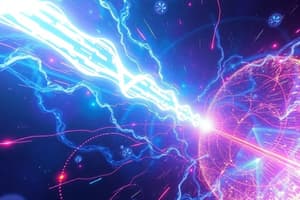Podcast
Questions and Answers
Explain the difference between luminous and non-luminous objects.
Explain the difference between luminous and non-luminous objects.
Luminous objects emit their own light, while non-luminous objects do not emit their own light.
Define rectilinear propagation of light.
Define rectilinear propagation of light.
Rectilinear propagation of light refers to the property of light to travel in a straight line.
What are some characteristics of light?
What are some characteristics of light?
Light is a form of energy, it travels in a straight line, and it makes things visible.
What is a shadow?
What is a shadow?
What is a mirror?
What is a mirror?
What is reflection of light?
What is reflection of light?
Flashcards
Luminous objects
Luminous objects
Objects that produce their own light.
Non-luminous objects
Non-luminous objects
Objects that do not produce their own light but reflect light from other sources.
Rectilinear propagation of light
Rectilinear propagation of light
Light travels in straight lines.
Shadow
Shadow
Signup and view all the flashcards
Mirror
Mirror
Signup and view all the flashcards
Reflection of light
Reflection of light
Signup and view all the flashcards
Study Notes
Light and Shadows
- Luminous objects emit their own light, whereas non-luminous objects reflect light from other sources.
- Rectilinear propagation of light refers to the straight-line path that light travels, allowing it to be focused and directed.
Characteristics of Light
- Light is a form of electromagnetic radiation.
- Light has both wave-like and particle-like properties.
- Light travels at a speed of approximately 299,792,458 meters per second in a vacuum.
Shadows
- A shadow is the dark area that appears on the ground or on other surfaces when something or someone blocks the light from shining on those areas.
Mirrors and Reflection of Light
- A mirror is a reflective surface, typically made of glass with a metallic coating, that reflects light and images.
- Reflection of light occurs when light bounces back from a surface, such as a mirror, without being absorbed or transmitted.
Studying That Suits You
Use AI to generate personalized quizzes and flashcards to suit your learning preferences.




